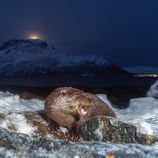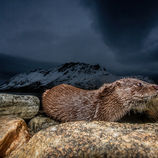Camera trap at my shoreline

September 2022 we moved to our little farm in Northern Norway with a shoreline of about 120 meters long. From the main house I have a good view over the shoreline and can observe our local wildlife easy from the living room window.

There is a quite good numbers of White-tailed eagles in our area so I placed some fish at the shoreline and waited to see if the eagles will come. In the beginning I saw mainly crows and magpies. Then a lot of ravens appeared, which gave me hope to see the white-tailed eagle soon.
the sound of the raven travels long and I earlier experienced that the white-tailed eagle very often shows up when he hears the sound of the raven.


At this time I didn't had any plan to use a camera trap at my shoreline.
I tried earlier to use a camera trap on the white-tailed eagle, but it seemed the sound of the camera scares
the eagle and the eagle might avoid my shoreline. I didn't want that.
For the future I have plans to build a photo blind at my shoreline to get closer to the eagles..
then unexpected an otter family, a female with 3 cubs, showed up and was eating from the fish I placed at the shoreline.
I was surprised that the otters came and were eating from the fish.
In general they are good hunters and like fresh fish.
That's when I started to work with the idea to install a camera trap to see if I'm able to get some images of the otters.

In the beginning I just placed my trail cam to see if the otters will be back at all.
I didn't needed to wait long before they showed up.


Now I was ready to place my camera trap, but I was a bit concerned how the otters will react.
Does the sound of the camera or the flash scare the otters away?
Just one way to find out and place a camera trap.

And I was lucky.
It didn't took long time and the otters appeared in front of my camera trap.
At this time I had not much experience with the otters and had no idea about their behavior.
To the left you see my first image of an otter taken with my camera trap. Not a very good image, but a good start for my little project with my local otters.
Canon 5D mark II + Canon 17-40mm f/4L USM
Settings: f/5.6 - 32mm - 1/25 sec - ISO2500
Now I know the otters don't mind the sound of the camera or the light of the flash.
From our shoreline we have a beautiful view over to the island of Uløya and I wanted to improve my images with a nice background. I also observed that the otters mainly are active at night, even if I have seen them during the day. One of my goals was to see if I can get a photo of an otter with the northern light in the background. That means I needed a longer exposure time, But this is not very easy. The otter is very often moving fast and that might be an issue using a longer exposure time.
I was lucky that the otters again showed up and now at dusk when it's still wasn't completely dark.
Canon 5D mark II + Samyang 14mm f/2.8
Settings: f/2.8 - 14mm - 1/50 sec - ISO2500
I was satisfied with the images where I could see the mountains in the background. We also got some snow which made it a bit more difficult, because some days the snow was just building up in front of my camera lens and also some moist was partly covering the glass of the lens.
Now I decided to do some changes in the settings to be able to get different kind of images and I also installed a second camera. One camera had settings for day photography, while the other one was set for night photography.
Here are some images from the camera with Day settings.
Canon 5D mark II + Canon EF16-35mm f/2.8L II USM
Settings: f/9 - 16mm - 1/125 sec - ISO1600
And here are some images from the camera with night settings.
Canon 5D mark II + Canon EF14mm f/2.8L II USM
Settings: f/2.8 - 14mm - 1.5 sec - ISO2000
I was specially satisfied with the images from the night where I got the full moon in the background.
Three days later the otters were back and this time I got the northern light in the background.
Canon 5D mark II + Canon EF14mm f/2.8L II USM
Settings: f/2.8 - 14mm - 1 sec - ISO2000
I always adjust my settings according to the light conditions, but it's not easy.
some nights are just darker, specially when the sky is covered with clouds.
I was very pleased how this little project worked out for me. I got some nice images and just wanted to proceed to see how the rest of the winter season will turn out.
But I did a major mistake and got a bit careless with evaluating the weather conditions.
One day we got very strong wind and a high tide.
you probably now know what that means, right?
Yes, after some very stormy days I went down to the shoreline to check my camera trap, but I couldn't found it.
Due to very strong wind and a high tide the sea washed my camera trap away.
I found one camera in front of our boat house and the other camera I found between some rocks around 20 meters away. You can image, everything was destroyed, but I was able to save some images from the memory cards.
here are some of the images I could save from the memory card.
Canon 5D mark II + Canon EF16-35mm f/2.8L II USM
Settings: f/8 - 16mm - 1/100 sec - ISO2000
































































